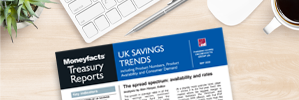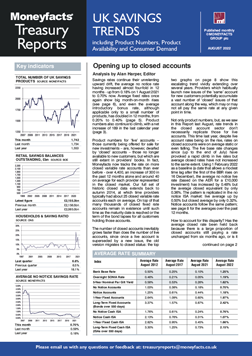Rachel Springall, Finance Expert at Moneyfacts, said:
“Savers may be pleased to see a record-breaking six consecutive months of improvement to interest rates, with some averages hitting their highest returns seen in the past decade. Product choice also rose for the sixth consecutive month, which included a rise in ISA products.
“Average ISA rates have seen notable improvements, with the average one-year ISA rate seeing its biggest month-on-month rate rise on our records, and the average longer-term fixed ISA rate seeing its biggest month-on-month rise in over a decade (since July 2008). Those savers who are looking to utilise their ISA allowance and fix for longer will find the average longer-term fixed ISA rate breached 2% for the first time since October 2014. ISA outflows continued in June, according to the Bank of England, but softened, as outflows to Cash ISAs was £353 million, down from £996 million. It will be interesting to see what the next few months will bring for savers who wish to utilise their ISA allowance, coupled with the potential need of ISA holders to dip into their savings amid the cost of living.
“While a rise in cash ISA rates is positive, there remains an obvious difference between the average fixed bond and fixed ISA rates, but it has narrowed this month. The rate gap between the average one-year fixed bond rate and equivalent ISAs and longer-term fixed bond rates and equivalent ISAs has fallen to 0.31% and 0.27% respectively. Providers have been making substantial rate rises to fixed bonds this year, so providers who also offer an ISA may now be increasing rates in this area to entice consumers where competition is rife in the fixed bond market.
“Fixed bond rates continue to rise, seeing the average one-year fixed bond climb closer to 2% (at 1.97%) and the average longer-term fixed bond hit its highest point (2.42%) since December 2012 (2.56%). The fixed rate bond shelf life rose to 40 days, up from 33 days a month ago, demonstrating a slight slowdown to activity within this sector, perhaps inevitable as last month’s shelf life was the lowest seen since October 2020 (28 days). Savers coming off a one-year bond wanting to fix for an equivalent bond could earn 1.37% more on average today (1.97%) than what was available 12 months ago (0.60%).
“Savers’ habits are already changing amid the rising cost of living. Indeed, according to the Bank of England, June saw an inflow of £250 million into interest-bearing sight deposits, the lowest amount recorded in any month during 2022. In contrast, there was an inflow of £1.9 billion for interest-bearing time deposits in June. Those savers could choose a notice account instead of a fixed bond or easy access account, as they can provide some flexibility and the average rate is at its highest in almost a decade. Whichever type of account savers decide to use, it’s imperative they consider any flexibility they may need in the months to come and keep a close eye on the top rate tables as rate rises dominate.”
Rachel Springall, Finance Expert at Moneyfacts, said:
“Savers may be pleased to see a record-breaking six consecutive months of improvement to interest rates, with some averages hitting their highest returns seen in the past decade. Product choice also rose for the sixth consecutive month, which included a rise in ISA products.
“Average ISA rates have seen notable improvements, with the average one-year ISA rate seeing its biggest month-on-month rate rise on our records, and the average longer-term fixed ISA rate seeing its biggest month-on-month rise in over a decade (since July 2008). Those savers who are looking to utilise their ISA allowance and fix for longer will find the average longer-term fixed ISA rate breached 2% for the first time since October 2014. ISA outflows continued in June, according to the Bank of England, but softened, as outflows to Cash ISAs was £353 million, down from £996 million. It will be interesting to see what the next few months will bring for savers who wish to utilise their ISA allowance, coupled with the potential need of ISA holders to dip into their savings amid the cost of living.
“While a rise in cash ISA rates is positive, there remains an obvious difference between the average fixed bond and fixed ISA rates, but it has narrowed this month. The rate gap between the average one-year fixed bond rate and equivalent ISAs and longer-term fixed bond rates and equivalent ISAs has fallen to 0.31% and 0.27% respectively. Providers have been making substantial rate rises to fixed bonds this year, so providers who also offer an ISA may now be increasing rates in this area to entice consumers where competition is rife in the fixed bond market.
“Fixed bond rates continue to rise, seeing the average one-year fixed bond climb closer to 2% (at 1.97%) and the average longer-term fixed bond hit its highest point (2.42%) since December 2012 (2.56%). The fixed rate bond shelf life rose to 40 days, up from 33 days a month ago, demonstrating a slight slowdown to activity within this sector, perhaps inevitable as last month’s shelf life was the lowest seen since October 2020 (28 days). Savers coming off a one-year bond wanting to fix for an equivalent bond could earn 1.37% more on average today (1.97%) than what was available 12 months ago (0.60%).
“Savers’ habits are already changing amid the rising cost of living. Indeed, according to the Bank of England, June saw an inflow of £250 million into interest-bearing sight deposits, the lowest amount recorded in any month during 2022. In contrast, there was an inflow of £1.9 billion for interest-bearing time deposits in June. Those savers could choose a notice account instead of a fixed bond or easy access account, as they can provide some flexibility and the average rate is at its highest in almost a decade. Whichever type of account savers decide to use, it’s imperative they consider any flexibility they may need in the months to come and keep a close eye on the top rate tables as rate rises dominate.”











